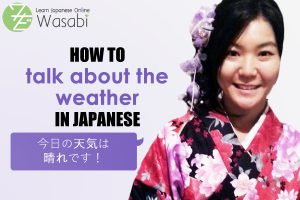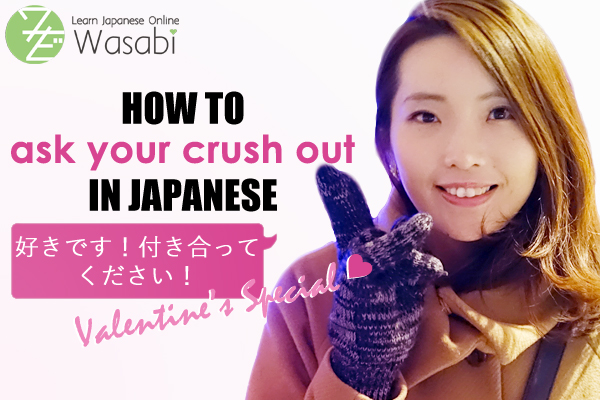Valentine’s Day Special: How to ask your crush out in Japanese
Welcome back to another “Video & Article” series, this time for our first live-stream with tutor Erika. In this article and video, Erika explains how Valentine’s Day and White Day are celebrated in Japan. And of course how to ask out your crush!
| Table of Contents [Introduction] [Valentine’s Day in Japan] [How to ask your crush out in Japanese] [Exchanging chocolates between friends?] [White Day] |
[Introduction]
Today we will take a look at something unique to Japanese culture: Valentine’s Day and White Day. Of course everyone has heard of Valentine’s Day, and it has become almost as big a deal here in Japan as anywhere else. So, how do you spend Valentine’s Day in your countries? And how many of you know about White Day?
Japanese Valentine’s Day is celebrated completely different from the rest of the world.
[Valentine’s Day in Japan]
In Japan, Valentine’s Day is celebrated in a very unique style. It is the women who give gifts to men! There is a tradition of women giving chocolate to men on Valentine’s Day. There are two types of chocolates, “Giri-choco” (obligation chocolate), and “Honmei-choco”.
義理チョコ
Giri-Choco, obligation chocolate
本命チョコ
Honmei-Choco, chocolate given to one’s boyfriend/husband or crush on Valentine’s Day in Japan
Giri-choco is meant to be for friends, colleagues, bosses, and close male friends. “Giri” means obligation hence this Giri-choco has no romance involved.
On the other hand, Honmei-choco is given to a boyfriend, lover, or husband with true love. Japanese women often prepare Honmei-choco by themselves as many of them think it is not true love if they just buy the ready-made chocolate at shops.
You will start seeing large displays of chocolate in department stores and grocery stores from mid-January to Valentine’s Day.
Days before Valentine’s Day, stores get packed with a large variety of chocolates, the cooking tools, and of course… women!
This is a conversation during this season.
For example:
チョコだれかにあげる?
Are you gonna give some chocolates to someone?
Actually, “チョコをだれかにあげる?” would be more grammatically correct, but particles are omitted frequently in spoken Japanese. The more polite way of saying this is: “チョコ(を)だれかにあげますか?”, instead of “あげる”. Then a reply to this is:
うん、上司にあげなきゃ・・・!もちろん義理チョコだけどね!
Yes, I have to give it to my boss. It’s Giri-choco, though.
And another example:
○○にチョコあげるの?
Are you gonna give a chocolate to ○○?
うん!もちろん!手作りだよ!
Of course! It’s gonna be handmade!
手作り(手・・hands 作り・・making)means handmade, homemade.
[adsense]
[How to ask your crush out in Japanese]
If you want to confess your true feelings, Valentine’s Day is a good time! So let’s see how we should ask him or her out!
好きです!付き合ってください!
I like you! Please go out with me!
付き合ってくれませんか?
Would you like to go out with me?
These are the most simple and straightforward sentences! “付き合う” (つきあう) is a verb and means “go out with~, dating”. It means “I think I like you so will you be my girlfriend/ boyfriend?”
Or if you are too shy, you can give chocolate with a love letter (or via social media) and in that letter you can tell your real feelings.
[Exchanging chocolates between friends?]
And also these days, we have another type of chocolate. It’s called “友チョコ” (ともちょこ)! “友” means friends in Japanese, so “Tomo-choco” means that you give chocolate to your friends. This is especially popular among girls.
友達同士(特に女性の間)で贈り合うチョコレートのこと。
最近ではこのように友達同士で贈り合って楽しむ友チョコが増えています。
Nowadays a lot of girls exchange chocolates with their friends.
[White Day]
Lastly, let’s talk about white day, a custom originating and mostly unique to Japan. White Day is a day that is marked in Japan and some other Asian countries on March 14, one month after Valentine’s Day.
On White Day, everyone has to go and kiss a white person. They must give someone white many presents and money and… no, just kidding.
On White Day the reverse happens: men who received any kind of chocolate (a “義理チョコ”, or a “本命チョコ”) on Valentine’s Day should return a gift. White chocolate, cookies, jewelry or even marshmallows seem to be popular among return gifts.
There is a term in Japanese called “三倍返し” (さんばいがえし), which means “triple the return”. “三倍” is “triple”, and “返し” comes from the verb “返す” which means to “return something”, e.g. a favor. This means the return gift should roughly have three times the monetary value of the gift originally received…!
That’s it for today. If you have any questions, you can always clear them up by booking a lesson with one of our native Japanese tutors. See you next time!
| 関する | To concern, to relate to |
| 行う | To carry out, to conduct |
| 義理チョコ | Giri-choco, chocolate given out Valentine’s Day out of obligation |
| 本命チョコ | Honmei-choco, chocolate given on Valentine’s Day out of love, to a boyfriend, husband, or crush |
| 友チョコ | Tomo-choco, chocolate exchanged between friends on Valentine’s Day |
| 上司 | Boss |
| 手作り | Hand-made |
| 付き合う | To go out, to date |
| 同士 | Among, between, fellow, mutual |
| 友達同士 | Among friends, mutual friends |
| 贈る | To send (a gift), to gift someone something |
| 贈り合う | To exchange gifts |
| 増える | To increase |
| 増えてくる | To gradually increase |
| 三倍返し | Triple return (referring to the value of White Day gifts) |

How to talk about the weather in Japanese

How to use “Yoroshiku Onegaishimasu” in Japanese



